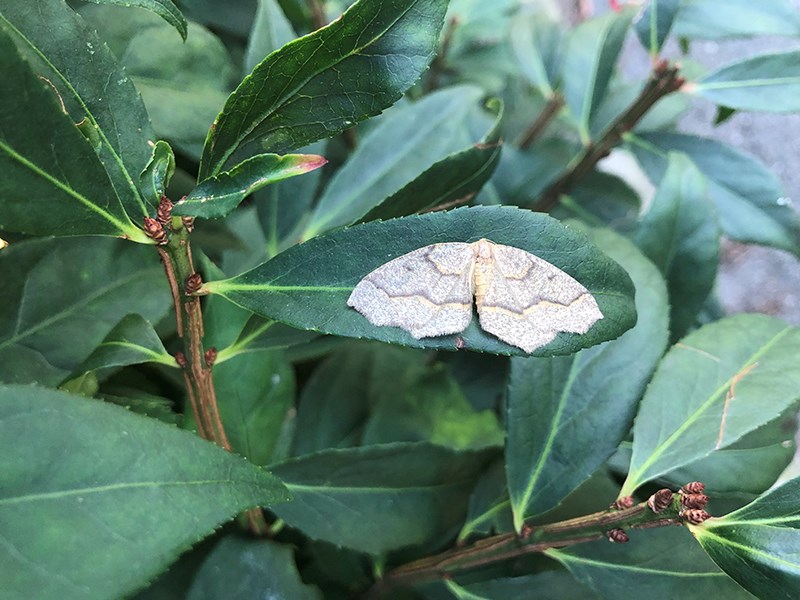Sunshine Coast and Lower Mainland locations, including the Powell River area, are subject to infestation of moths.
According to Babita Bains, provincial forest entomologist, the region is experiencing western hemlock looper and phantom hemlock looper outbreaks.
“More than 2,000 hectares of coastal forests have been impacted by the loopers,” said Bains. “Western hemlock looper populations commonly build every 11 to 15 years in British Columbia’s coastal forests. The last recorded phantom hemlock looper outbreak was in the Port Mellon area in 2001.”
Bains said trees typically survive light and moderate severity defoliation, however, severe defoliation can result in growth reduction, top kill and tree mortality.
“To monitor the impacts, the ministry of forests, lands, natural resource operations and rural development annually surveys the province using fixed-wing aircraft,” said Bains. “From these surveys, the ministry is able to estimate impacts caused by various forest health agents.”
Bains said it is too early to determine how much of the impacted forest will survive or die. It is important to note that the looper is a native defoliator and outbreaks are an important component of ecosystem disturbance, she added.
In terms of treatment for these moths, aerial application of Btk (Bacillus thuringiensisvar Kurstaki)can be used to reduce looper populations. Bains said it is used across BC to manage various defoliators to minimize timber volume losses. She added that Btk is a bacteria that is naturally present in urban, agricultural and forest soils around the province and only impacts caterpillars.
“Aerial spray programs to manage loopers are not commonly used on the coast considering the volume losses are not significant enough (the return on investment isn’t there), plus these outbreaks are natural and an important component in maintaining a healthy ecosystem,” said Bains.
In terms of the kind of devastation these moths can create in conifer forests, Bains said trees will die from severe defoliation, especially if they are already stressed or are over-mature trees.
She said adults (moths) fly in September and October, lay eggs on branches and tree trunks, the eggs sit over winter and in the spring caterpillars emerge and begin feeding.
“The loopers are considered wasteful feeders as they consume only parts of needles and feed throughout a tree crown,” said Bains. “During an outbreak, the caterpillars will feed on a range of conifer hosts and understorey plants. Tree defoliation will result in host stress and in severe cases, mortality.
“Typically, stressed, mature and over-mature trees are more likely to be killed by looper defoliation. I will note that mortality in these susceptible stands can be beneficial (i.e. allows younger/suppressed trees to emerge, supports the recycling of ecosystem nutrients, et cetera).”
Bains said the moths do not attack the trees, rather, the larvae (caterpillars) feed on the needles of trees starting in mid-June to mid to late-August.
“Once they have finished feeding, they pupate, which takes about 10 days, and then emerge as adults,” said Bains. “The adults are currently flying as they are looking for mates. Once they mate, the female lays eggs and they die. The flights usually go from the end of August to the end of September.”
Bains said the ministry is monitoring the situation by completing aerial overview surveys and detailed surveys to quantify the impacts.
“This was an expected event,” she said. “Monitoring is valuable as it will allow us to determine if this outbreak was more severe (more mortality or broader impact/larger area impacted) or similar to past outbreaks, considering stressors associated with climate change may change the impact or severity of these expected outbreaks.”
Bains said aerial survey data is used to quantify the impacts. She said the ministry also monitors looper populations via trapping. Traps are set-up in the fall to get estimates of the adults and breeding population. Bains said the trapping data is used to monitor the populations.
The outbreak started in 2019, according to Bains.
“We are in year two of what could be a three-year outbreak,” she said. “It is likely that the coast will experience another season of defoliation next year, however, it may be of lower severity.
“It is difficult to predict as the populations could crash unexpectedly, due to an increase in natural virus and predation, or persist next year.”



